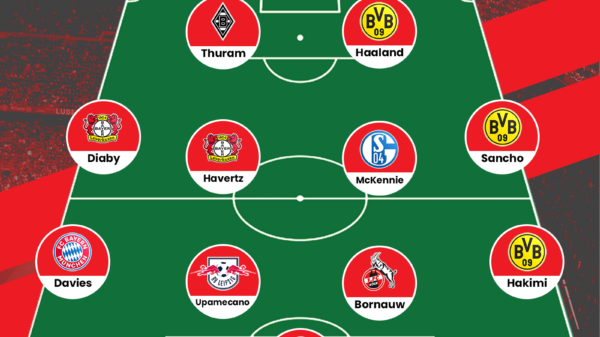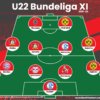Borussia Dortmund came into the game knowing that they had to pull off nothing short of a miracle to stand any chance of getting past Real Madrid in the Champions League quarter-finals. They knew that even a repeat of their 4-1 triumph last season at home, wouldn’t be enough. Jurgen Klopp had to go for the win, while a Ronaldo-less Real Madrid knew that even one goal would be enough.
It was vital then that Dortmund came out the stronger attacking side, they needed the victory more than their opponents and were ensuring that they controlled the game. When Madrid received a penalty, it seemed like ‘game-over’ but the save from Weidenfeller spurred the side on. Two quick goals by Reus before half-time changed the complexion of the game, and if it wasn’t for some poor Mkhitaryan finishing, Dortmund would have (at the very least) ensured extra time.
Dortmund 2-0 Real Madrid

Line-ups created using Tactical Pad
Line Ups
Dortmund: Weidenfeller; Piszczesk (Aubameyang, 81′), Friedrich, Hummels, Durm; Kirch, Jojic; Reus, Mkhitaryan, Grosskreutz; Lewandowski.
Real Madrid: Casillas; Carvajal, Pepe, Ramos, Coentrao; Illarramendi (Isco, 45’), Alonso, Modric; Di Maria (Casemiro, 73’), Benzema (Varane, 90’), Bale.
Goals: Reus 24’, 37’
Borussia Dortmund pressing
For Dortmund to stand any chance against a formidable Real Madrid side, they knew they had to stick to their basics. And Dortmund’s basic approach starts from their pressing game. Their ability to prevent the opposition from having any space, ensuring that the ball is recovered within 2-3 seconds of losing it, is where the German side’s strengths lie. And this is where Dortmund were impressive again. While the pressing was immense throughout the pitch, it had the most telling effect in the midfield area.
Had Real’s midfielders been given some time, they would have been able to pick out the right passes, to play their wide men through. Bale & Di Maria could have beaten Dortmund’s defence pace-for-pace and picked out passes for Benzema, given Dortmund’s fairly high line. But the pressing was at its peak in the midfield area. It prevented Real from having the slightest chance of picking out the perfect pass for the wide men. Even the experienced heads like Alonso struggled against Dortmund’s pressing, and for the younger players like Illarramendi, it was a whole new playing field as the ex-Real Sociedad man was taken off at half-time with Ancelotti realizing he was struggling.
MORE READING | Real Madrid 3-0 Borussia Dortmund: Tactical Analysis
Interview with NY Times journo and Dortmund expert, Cristian Nyari
Klopp did a good job of identifying that the midfield needed to be shutdown primarily, to prevent service to the attacking third, rather than purely keeping the attackers quiet. By nullifying the effect of the midfielders, Dortmund took away half of Real’s attack, or at least the much needed service to it.
The pressing obviously also allowed the home side to retain possession in key areas, such as the midfield zone, allowing them to start attacks. The pressing didn’t force Real back but did draw them further out, meaning that once possession was won, Dortmund had a numerical equivalence in terms of their attacking players and Real’s defence. The pressing also allowed Dortmund to dictate the tempo of the game, to suit their fast-paced game.
Failed Gareth Bale experiment
Now we were aware that Ancelotti would be forced to switch things around in terms of his team selection with Ronaldo not being available to start in the XI. Illarramendi was put into the side (and as we documented, he struggled to keep up with Dortmund’s pressing & pace), while Di Maria was pushed higher up to take up his position in the attacking trio.
When Ronaldo is fit, he plays down the left cutting into the centre while Bale plays of the right cutting into the centre as well. With Di Maria included into the front three, in place of Ronaldo, a problem arose because Ancelotti couldn’t play both his wide attackers inversely as both were left footers. Carlo then opted for Di Maria on the right and Bale on the left. Although the left is Bale’s ‘’natural position’, it’s his ability to cut in that makes him so dangerous. And he was required to cut in onto his right against Dortmund as well. Ancelotti believed that Bale was more capable of using his right foot as he cut in than Di Maria.
But as we noticed in the first-half, Bale was struggling to cut inside with Dortmund players easily showing him onto his left foot. He was forced to play as a traditional winger, which didn’t suit Real’s play. It became a game of putting crosses into the box, which Dortmund were able to win.
Ancelotti consequently switched Gareth Bale onto his usual Real position, the right side of the attack where he was able to have more of an effect.
Real wary of Lewandowski
What do you do when a player has terrorised your defence, like no one ever before him, just a year back at nearly the same stage. Well Ancelotti went back to the basics, like you would in any non-competitive recreational football match. You throw all your defenders to get close to the danger man, put tackles in when he has the ball, crowd him out of the game.
That’s what Real were forced into against Dortmund’s Robert Lewandowski. The Polish striker had put four past them in the semi-finals, a year back, at the Signal Iduna Park. Ancelotti had to ensure that the same thing didn’t occur for a second year running.
As expected, Lewandowski was the furthest man forward for the Dortmund side. He isn’t one that usually drops deep to dictate play, playing more of a centre forward’s role in game. This meant that the Real central defenders stuck close to the striker, both on and off the ball.
This consequently worked in Dortmund’s favour as it meant that there was more space and time open for the other attackers to exploit; most notably, Reus and Mkhitaryan benefited. The latter obviously fluffed a couple of easy chances, including an open goal, which would have forced the tie into extra-time. Reus on the other hand took his chances, scoring a brace.
In fact, the only moment in the match where Lewandowski found himself in some form of space/time with the ball, his shot came back off the post, only to be turned into the net by Reus. By negating Lewandowski’s effect, Real ensured that there was no repeat of last season’s heroics from the Pole which eventually got them through to the next round.
Should Klopp have made substitutions earlier?
Dortmund’s injury troubles are well known and they were evident in the starting eleven as well. The likes of Kirch and Jojic have barely seen first-team football this season, but were thrown onto the pitch against one of the best sides in Europe. No doubt that a remarkable job was done, but one has to wonder, could Klopp have made some changes earlier on?
Dortmund’s attack was terrific on the night, but they made just one change, getting Aubameyang on in the 81st minute to replace Piszczek. The change was right, but with under 10 minutes left, it had little effect. Bringing Aubameyang on earlier, between the 60th & 70th minutes could have had a more direct impact in terms of injecting pace. Dortmund also had Scheiber and Hoffman on the bench, who could have impacted the game, had they come on. They would have maintained the pace of their attack in the final third, something that naturally subsided as the game wore on.
Mkhitaryan was having a shocker of a game himself something that did his and the teams’ confidence no good. It would have been a brave move to take out one of the stronger players from the squad, but shifting Reus to the centre and adding another wide man seemed a good option which Klopp had available.
Real’s weakness comes to light
Although Real have gotten through to the semi’s, one thing is clear that no side can be called a clear favourite. Real are definitely one of the strongest sides in Europe, but display signs of weakness when faced with a pacey attack. Dortmund’s defence was solid as well in preventing any meaningful chances being created.
If Ancelotti’s men come up against a pacey Bayern attack, or a tight Atletico/Chelsea defence, they could have a tough time. Real aren’t masters of sitting deep and tightening their defence. Good open play is what they rely on. This is something that can be exploited easily on the counter, with pace. Additionally, their attack can suffer when the final third is tightened.
Where does this leave them?
Real Madrid are third in the La Liga, and consequently outsiders in many people’s eyes for the Spanish title. La Decima remains their priority, as they look to break the wait having reached the semi-finals for five consecutive seasons, without reaching the final. They do also have an El Clasico coming up in the Copa Del Rey final.
Dortmund were out of the title race in the Bundesliga months ago, and with Bayern having secured that title, their attention will turn to the DFB Pokal Cup, where they have a semi-final to play vs Wolfsburg. The side can be proud of nearly pulling off a miracle with a largely weakened side.
For more Tactical Analysis of the biggest games across Europe, head this way.


























































